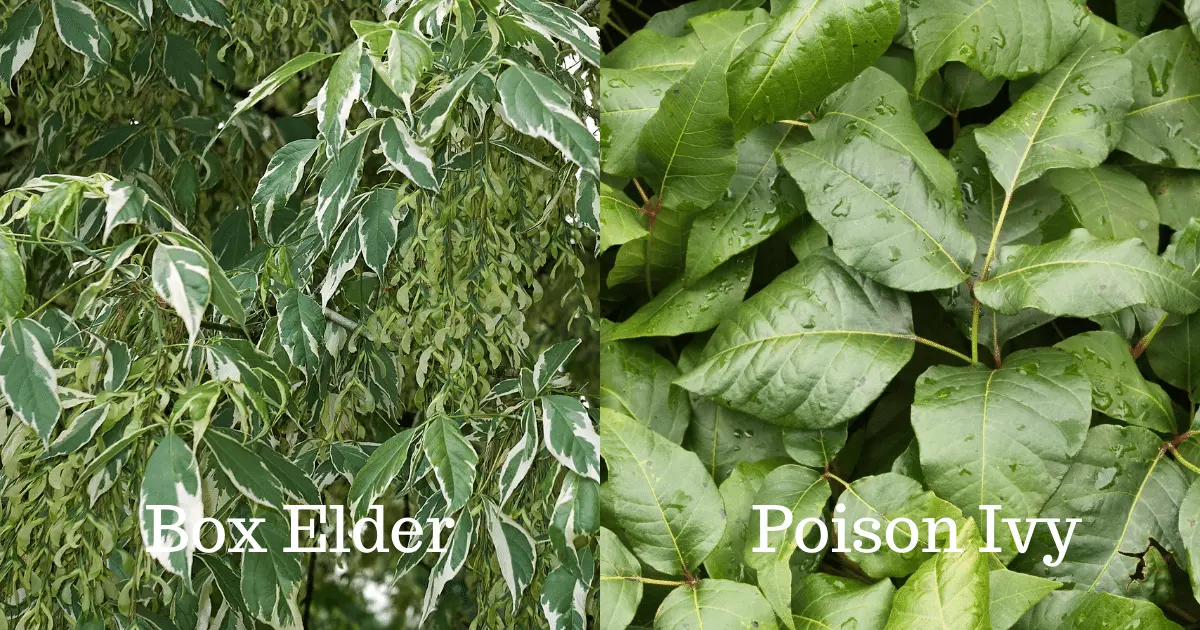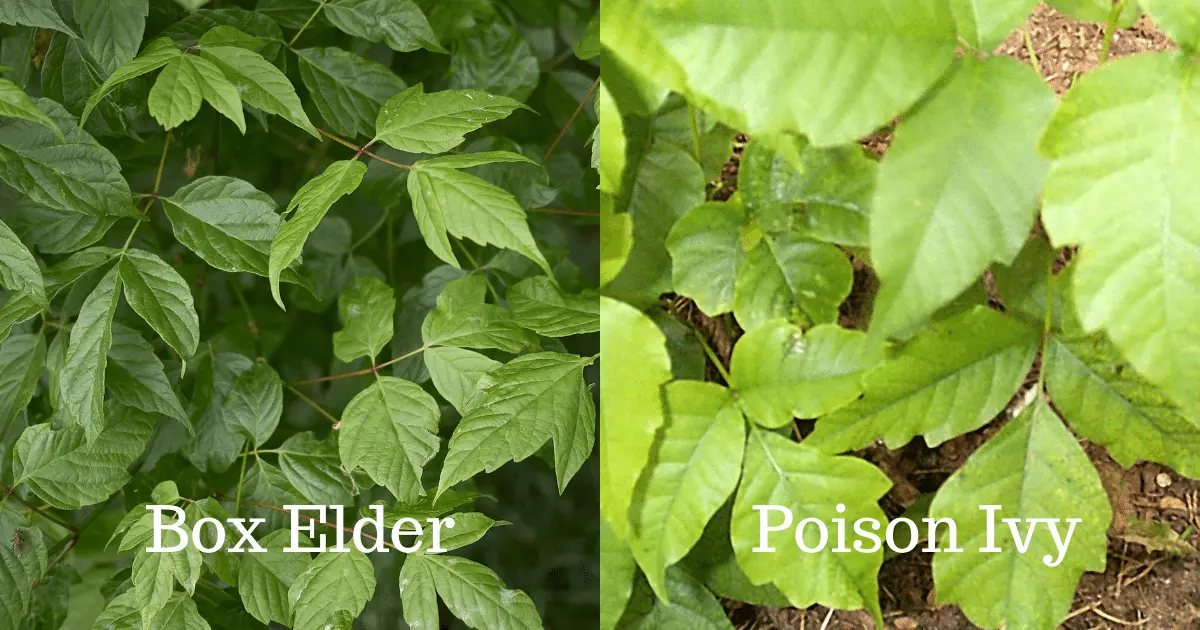Box Elder and Poison Ivy plants share striking similarities and are often difficult to tell apart, especially if you have no training or experience. While this isn’t a big deal in some situations, it can be in others.
Box elder is often confused with poison ivy only in its young life as a sampling. Both plants have compound leaves consisting of three leaflets, with the middle leaflet on the longest stalk.
Box Elder vs. Poison Ivy

Box Elder (Acer negundo) is a member of the Aceraceae plant family. It is sometimes referred to as the ash maple tree or the Manitoba maple tree. For this reason, it is the only maple tree with three leaflets on each stalk.
Box elder is native to the central and eastern United States. Although, it is introduced to Europe and is widely cultivated there as an ornamental. The wood of the box elder tree is soft and has no commercial value.
The tree grows to 9-15 m (30-50 feet) tall, and it helps to shelter wildlife and stabilize stream banks. According to research, some box elder trees are male and female.
The females bear blossoms that turn bright green when pollinated and add color to your spring garden. The female trees also attract box elder bugs but don’t cause many problems in the garden.
Poison Ivy (Toxicodendron radicans) is one of those plants no one wants to find in their garden, around their homes, or near their campsite. As a result, many people refer to it as the “Devil Plant.” Poison plants can be found in every state in the United States except Alaska and Hawaii.
It is commonly found in the Eastern and Midwestern states but doesn’t grow well in areas of high elevations. Poison ivy plant grows in an alternate leaf arrangement on the main stem, which means they can grow on different stem nodes.
The leaf has three leaflets, the main stem; the middle leaflet normally has a longer stem than two leaflets on the side that aren’t symmetrical. They can grow 2-6 inches long, and the leaves are normally twice as long as they are wide.
| Box Elder | Poison Ivy | |
| Botanical name | Acer negundo | Toxicodendron radicans |
| Plant type | Tree | Deciduous tree |
| Family | Aceraceae | Anacardiaceae |
| Mature size | 9-15 m (30-50 feet) tall | 1.2 m (4 ft) tall |
| Sun exposure | Partially shaded area | Full sun |
| Soil type | Moist | Fertile, moist, well-drained soil |
| Soil pH | 6.5 to 7.5 | 3.6 to 6.5 |
| Bloom time | Early and mid-spring | May to July |
| Flower colour | Yellow-green | Yellowish-green to greenish-white |
| Hardiness zones | 2-10 (USDA) | 4-8 (USDA) |
Both plants are green; their stems have three leaflets, and the leaves have a similar shape. They tend to grow in the same places, which includes; along fences, around or behind the garage, along walking trails, your backyard, and other places you don’t tend to often.
The main difference between these two plants is the leaf arrangement. A box elder tree has an opposite leaf arrangement; they grow across from one another. While poison ivy has an alternate leaf arrangement meaning they grow on alternate nodes.
Uses
Box elder can be used for a variety of purposes. The wood is light, soft, weak, and low commercial value. It is also used for pulp and rough lumber, usually mixed with other bottomland species, and has been used for boxes, crates, low-quality furniture, and interior finishing.
Traditionally, native American tribes use the box elder plant to treat respiratory conditions, kidney infections, paralysis, swellings, and other ailments. For culinary use, box elder produces sap high in sugar content and can be used to produce syrup, sometimes called “Mountain molasses.”
On the other hand, poison ivy is a poisonous plant that causes an itchy skin rash. It releases an oily sap called urushiol that results in irritation, an itchy allergic reaction.
This can happen by simply rubbing up on the plant but can also spread from your clothes or garden tools. You can find this oil on the plant’s leaves, stems, roots, and berries.
Growing Conditions
Box elder trees can grow in almost any mild, cool, or cold region in the United States. They thrive best in USDA plant hardiness zones 2 through 10. It can be planted near a stream or river if possible.
They prefer moist soils, including sand and clay, and can grow well in dry or wet soil. When growing from seeds, it can be planted in any moist medium. The seeds can be inserted into the medium or distributed on the top.
Always remember to protect the seeds and seedlings from frost. The seedlings will start sprouting in the spring and grow to a height of 2 to 3 inches within the first few months. This way, it can be transplanted and will need no special requirements other than regular watering.
Poison Ivy grows as a vine, small shrub, or ground cover that may run along the ground or up the sides of trees, houses, or other vertical surfaces. It grows in various climates and is a threat year-round in most places.
Usually, poison ivy grows as a green vine in the spring and shows signs of buds and white flowers. The next season, the flowers bloom into berries then the leaves change color in the fall. Then in winter, it disappears.

Light
Box elder prefers a partially shaded area for best growth. When exposed to direct sunlight in the summer, the leaves of most varieties will wither. Poison ivy prefers moist, rich soil in full to part shade.
Soil
Box elder plant is a forest native, so it doesn’t have many specific requirements for soil. It prefers well-drained soil that is rich in humus and slightly acidic. Its main root will extend deep into the soil, but its tiny fibrous roots will be concentrated near the soil surface in a way that accumulated water in the soil tends to cause root rot.
Poison ivy can tolerate various soil conditions and has grown best in clay, silt, loam, and sand soils.
Planting
The best time to plant box elder plants is following defoliation in the fall. During this time, the leaves will have fallen off, so there will be little transpiration, and water loss can be avoided.
Poison ivy grows very quickly and propagates itself through underground rhizomes and seeds.
Watering
In the summer, box elder seedlings growing in pots require watering twice daily, in the morning and evening. Watering should be carried out in the spring depending on the actual conditions, while in winter, ensure the soil stays dry.
Fertilizer
Fertilizer should be applied depending on when you grow your box elder seeds. For potted seedlings, slow-release fertilizer is advisable. For seedlings grown in gardens, fertilizer should be applied three times a year, once in early spring, once in early summer for growth, and once in the fall.
Pruning
It is advisable to prune a box elder plant in the fall because withered and fall buds can easily be identified. Poison ivy has a complex root system, so it’s best to use shears or pruners to remove the stems.
Note: Before pruning your poison ivy, allow your plant to go dormant over the winter-between late winter and early spring or when new growth starts to appear. Grab your clean pruners or trimmers and cut away any dying, damaged, yellow, or declining foliage. Make sure you repeat the process until you reach the base of the plant until there are no dead pieces left to cut.
Common Pests and Diseases
The box elder bug (Leptocoris trivittatus) is the most common bug that affects the box elder tree. The bug emits a foul odor, stains fabric, and can cause an asthmatic reaction. The bug is one of the main reasons people avoid boxelder trees when possible.
They are commonly in or around boxelder trees and are native to the western states. They are about ½-inch in size, have six legs, are black with reddish markings, and are elongated oval in shape.
Poison ivy is the ultimate weed that no one wants. All parts of the plant contain volatile oils that can cause significant skin irritation on direct or indirect contact.
